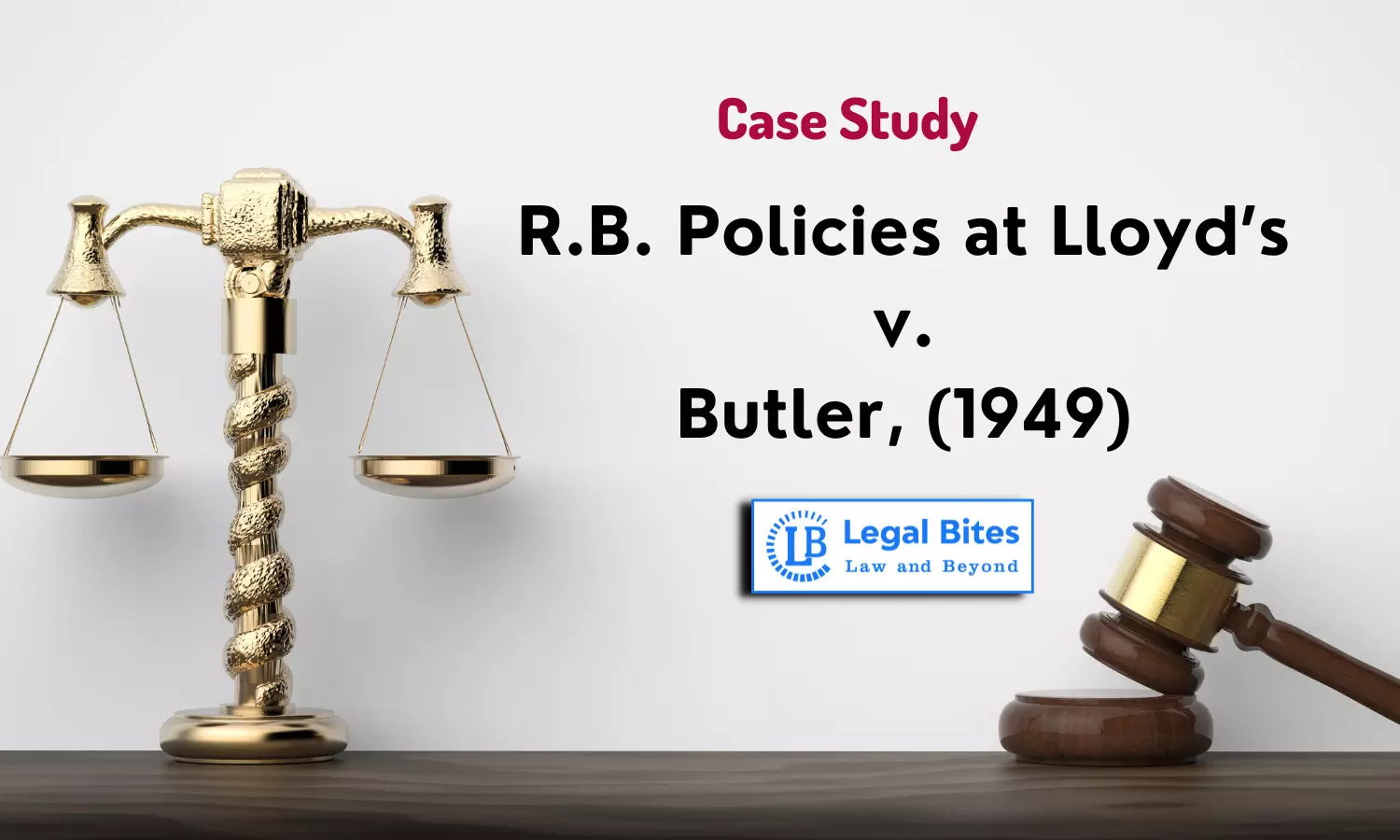Case Study: R.B. Policies at Lloyd’s v. Butler, (1949) | Protection against Stale Demands
Dive into the pivotal legal precedent 'R.B. Policies at Lloyd’s v. Butler' that significantly shaped the interpretation of the Limitation Act.

Dive into the pivotal legal precedent 'R.B. Policies at Lloyd’s v. Butler' that significantly shaped the interpretation of the Limitation Act.
Title of the Case: R.B. Policies at Lloyd’s v. Butler
Citation: (1949) 2 All ER 226 (KBD)
Bench: King’s Bench Division: Justice Streatifeild
Introduction
The legal case titled "R.B. Policies at Lloyd’s v. Butler" sets a precedent for the interpretation of the Limitation Act, specifically in cases involving stolen property and innocent buyers. The judgment establishes a standard for navigating the application of the Limitation Act, highlighting the delicate equilibrium the law must maintain in protecting property rights while preventing injustices. This case stands as a cornerstone in UK legal precedent.
Mr. Butler and R.B. Policies at Lloyd’s were parties in conflict. A significant legal principle was established by the court’s ruling in this case, and it has subsequently been upheld. It made clear how the law defines and safeguards property rights. The deadlines for filing cases are established by the statute of limitations. The court’s decision in this particular case contributed to the establishment of rules and restrictions on the use of these deadlines (limitation). The 1939 Limitations Act’s interpretation and rights of ownership are still impacted by the remarkable decision of this case
In this particular case, a motor car that had been stolen was ultimately sold to Mr Alfred Butler, a passer-by who was unfamiliar with any of the previous matters associated with the car. The vehicle in question went missing in 1940 and belonged to a man identified as R.B. Policies who worked for an entity called Lloyd’s. This incident was unknown to the original proprietors. Over six years following the theft, the vehicle was sold to several purchasers. Finally, a man named Mr. Butler purchased it. It was found that Mr Butler owned the vehicle which belonged to another individual in 1947. As a result, the original owners began a legal procedure to reclaim the vehicle.
Facts
- This legal case was initiated by R.B. Policies at Lloyd's against Mr. Alfred Butler through a writ filed on July 16, 1947. The plaintiff seeks the recovery of a motor car, contending that the defendant has unlawfully held onto the vehicle.
- The people suing claimed that they were the original owners of the vehicle in question.
- The defendant, acting as an innocent purchaser, acquired the vehicle at a fair price and in good faith several years after it had been stolen.
- On June 27, 1940, an unidentified individual took possession of a motor car registered as JD 6412, originally owned by the person making the claim.
- The vehicle, which at that point had registration number ALN 765, was found in the possession of the defendant in January 1947. Over the preceding seven years, it had been passed down to him via a series of intermediary buyers.
Issue
- When did the cause of action accrue?
- Whether the claim made by the plaintiff time-barred under the Limitation Act, 1939?
- Whether the ignorance of the plaintiff regarding the identity of the person who committed the conversion could be deemed sufficient to prevent the accrual of the cause of action?
Laws Applied
The applied laws here are Section 2(1), Section 3(1) and Section 26 of the Limitation Act, 1939
Contention of the Parties
- The plaintiff, in the present case, claimed the car from the defendant, as per whom, the possession of the defendant was not lawful.
- Plaintiff argued that their car was stolen, and they had a valid reason to take legal action, therefore the claim is valid.
- Defendant contended that section 2(1) of the Limitation Act, 1939 stated that no action may be instituted “after the expiry of the six-year term following the day when the cause for action developed,” bars the plaintiffs’ grounds of action.
- The defendant argued that the plaintiff’s failure to disclose the identity of the alleged thief did not prevent their cause of action from accruing. Plaintiff allegations against the purchaser who bought the car honestly would result in an unfair consequence.
Judgement
The insufficient knowledge of the plaintiff of the true identity of the offender did not affect the court’s ruling since the root cause for action began to rise when the automobile was taken in 1940. They understood the intent of the limitation law to be to shield undoubtedly innocent holders against irrelevant claims raised many years after the incident to avert unjust practices.
As a result, the court ruled in support of Alfred Butler, the party arguing for the defendant, and dismissed the plaintiff’s claim that was filed many years following the theft that occurred against the innocent buyer. The Court emphasized one of the principles of the Limitation Act, which showed that those who go to sleep on their claims should not be assisted by the courts in recovering their property.
Therefore, this decision emphasizes how important it is to strike an equilibrium between the legal entitlements given to original holders and the interests of genuine purchasers. It serves as an example of the significance of the act of limitations in claims in court, guaranteeing that the legislation guards against out-of-date claims that could unjustly affect people who have lawfully obtained properties with good faith.
Contributions from: Laiba Tahreem And Apurva Neel

